Kärcher pressure washers are unrivalled for patio cleaning, car washing, and pretty much anything else you might ever need to wash effectively.
So, rather than pulling together a huge list of the best pressure washers on the market, we thought we’d take a look at one of the worlds leading brands and deep dive into their products so here is our list of the best Kärcher pressure washers you can buy today.
We’ve got handy hints and tips for how to use pressure washers most effectively, and what to look for when you’re picking one out for domestic or commercial use.
More...
Product | Our Rating | Price | |
|---|---|---|---|
1. Kärcher K7 Compact High Pressure Washer - 2600PSI |  | ||
2. Kärcher K5 High Pressure Washer - 2300PSI |  | ||
3. Kärcher K2 Electric Pressure Washer - 1600PSI | 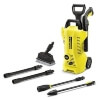 | ||
4. Kärcher G 3000 High Pressure Washer - 3000PSI |  |
Best Kärcher Pressure Washer Reviews
1. Kärcher K7 1.447-055.0 Compact - 2600PSI
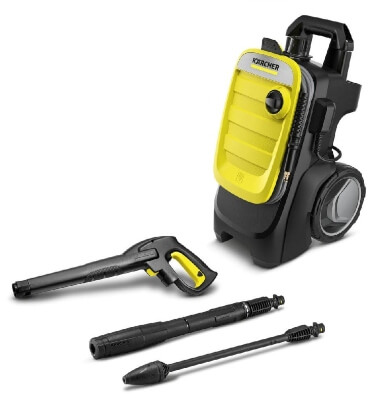
Kärcher K7 1.447-055.0
When we jump down into the electric pressure washers there’s so much more choice, but also more limited power. Electric pressure washers have never had the same capabilities as petrol models, but they are easy to use, friendlier for the environment, and beautifully compact.
The Kärcher K7 is one of the smallest and neatest on the market and packs a real punch at 2600psi. For car cleaning, window cleaning, and most patio jobs, the Kärcher K7 is perfect, and really, really good value too.
Pros
Cons
2. Kärcher K5 1.324-674.0 Compact - 2300PSI
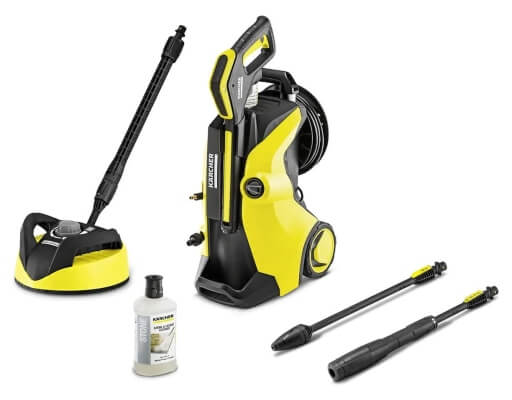
Kärcher K5 1.324-674.0
The Kärcher K5 is exactly what you expect from a Kärcher pressure washer. Its body is cleverly designed to hold most of its attachments, and it’s really easy to add in shampoos and detergents which automatically mix into the water stream.
Apart from the power and noise the next biggest difference between petrol pressure washers and electric Kärcher pressure washers is the accessories kit you can get with each model.
Electric washers come with all sorts of gadgets to boost their power and help to target water flow. The Kärcher K5 includes a clever Dirt Blaster tool which directs water and recirculates the pressure on patios to remove stubborn dirt.
Pros
Cons


Get Your Free Guide:
Master Growing Australian Natives eBook
A Must Have Complete Guide for Every Australian Garden
Get Your Free Guide:
Master Growing Australian Natives eBook
A Must Have Complete Guide for Every Australian Garden
3. Kärcher K2 1.673-411.0 Electric Pressure Washer - 1600PSI

Kärcher K2 1.673-411.0
Karcher K2 Review:
1600psi might be the lowest pressure that Kärcher makes, but it’s still a good bit of kit for most homeowners and is considered among the best entry level pressure washers. To put it into context, the petrol models are definitely necessary for the first attack on serious dirt, but for ongoing maintenance, or regular car, fence, or window cleaning, Kärcher K1 is a really good range.
The low pressure does mean it doesn’t work with some standard attachments, but there is a good range of specially adapted nozzles and brushes that come with the Kärcher K1 so you can tackle most jobs efficiently.
Pros
Cons
4. Kärcher G3000 9.506-954.0 High Pressure Washer - 3000PSI
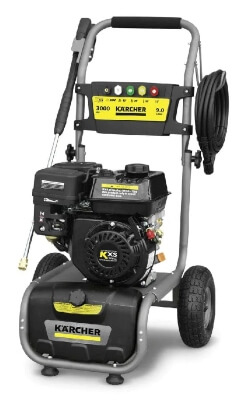
Kärcher G3000 9.506-954.0
Karcher G3000 review:
I really, really like this compact G 3000 model, with 3000psi making it the only practical choice for domestic gardeners who need something more powerful than standard electric models but don’t want to give up masses of garage space for the luxury.
As well as a high, 3000psi, spray, it comes with sturdy tires, durable fittings, and a reliable engine designed and manufactured by Kärcher themselves.
Pros
Cons
Kärcher Pressure Washers 2025 Buyers' Guide
Getting to Know Kärcher's Pressure Washer Range
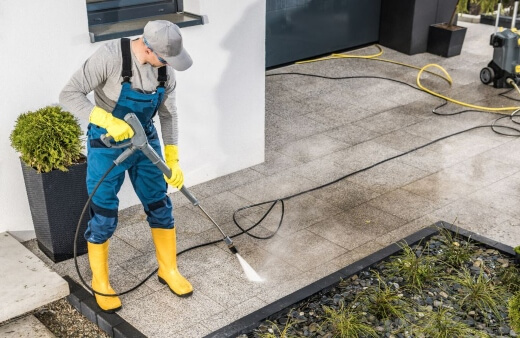
Kärcher produce a huge range of cleaning tools, from vacuums, carpet cleaner and window cleaners to floor mops and polishers, but their key product has always been their powerful range of pressure washers.
Kärcher pressure washers are designed to take worked-in dirt out of the toughest of surfaces and bring some sparkle back to your home. If you’re thinking that you can get the same results from a stiff brush, think again.
When we first bought our house (a run-down collection of bricks and broken garden walls) the patio, the walls, the render, and pretty much everything else was covered in worked-in mud, oil spills, and strained from rusty outlets.
After a lot of experimentation, the only tool that got our home looking even close to ready was a petrol-powered Kärcher pressure washer.
Once we’d finished renovations we broke the pressure washer back out, and blasted away the render, mortar spills and builders’ dust too, leaving us with a pristine patio that turned out to be some pretty nice sandstone hidden under years of neglect.
Buying a Kärcher Pressure Washer
Buying one is pretty straightforward, with a logical pricing system based on power, durability and pressure. Essentially, you get what you pay for. However, for most domestic applications the smaller models can be more than enough for routine maintenance, or occasionally cleaning the car.

Let’s take a quick run through what to look for in Kärcher's pressure washer range; from power and PSI to overall performance.
Power
Kärcher uses the same Petrol engine for most of their gas-powered units (196cc 4-stroke Honda GX) but a few have Kärcher’s own duplicate engine (also 196cc 4-stroke).
Their petrol engines are significantly more powerful than their electric models, but the main-powered engines are still capable of around 2600 PSI in the higher price range.
PSI
PSI is the most important measure of a pressure washer’s ability, but it should be coupled with power. Lower-powered models can pump water through at a similar pressure to high-powered Kärcher pressure washers but they pump less water and rely largely on the system pressure in your mains.
For serious commercial work 3000PSI or above is needed. For domestic models, look for something around the 2000-2500 PSI mark which can beat down almost any of the worst garden grime.
Kärcher pressure washer accessories
Kärcher pressure washers come with a wide range of attachments and accessories. The high-powered petrol models are usually straightforward, with one high-powered nozzle, which (thanks to the high PSI) can remove almost anything.
The smaller electric models have some good tricks up their sleeve though, with purpose-built dirt-blasters, rotary nozzles and jet nozzles that help to target dirt in different directions.
Kärcher Model ranges
Domestic models are sold under K1, K2, K3, K4, K5, K6, or K7 model ranges. The lower the number, the lower the pressure. When you get out of the domestic range and into the commercial petrol-powered models, there are some pretty big jumps in price.
How to Use a Kärcher Pressure Cleaner
The first time I used one, I got a little bit carried away and just went for it, but despite the fun you can have with them, they work best when used slowly, and methodically. Even if you’re just trying to blast off small spots, it’s best to work around the entire area.
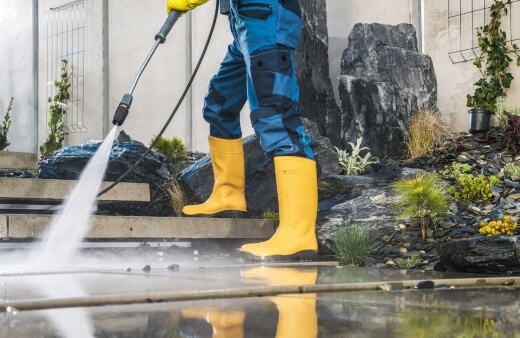
Using it on small spot cleaning jobs tends to leave spots of sparklingly clean floor, and highlight the dirt elsewhere, so be prepared to do more than you intended to.
Start by getting everything set up:
- Connect the hose outlet from your retractable hose reel to the machine.
- Clear your workspace.
- Power on the machine (make sure any wires are neatly wound so you can pull without tugging at the plug).
- Choose the appropriate attachment (thin jets are the most universal).
Then you’re ready to go. We would always recommend starting lower down, particularly if your patio tends to pool.
Kärcher pressure washers pump a vast amount of water through in a short space of time, so start where the water will pool, then work away, to avoid ending up spraying into a puddle.
Work in methodical strips, particularly on hard dirt, where clear lines will show. If you are removing lichen from pacing, work over patches a few times until the fizzing stops.
Lichen spores as it's sprayed and spores remain until the fizzing completely stops (consider treating the entire patio with a lichen or moss killer later).
Kärcher Pressure Washers Safety Guide
Kärcher pressure washers are generally safe to use, but the really high-powered models (3000PSI or more) can do real damage and even cut through skin so wear long sleeves and thick trousers when working with pressurised water.
Kärcher Pressure Washer FAQs
Is Kärcher pressure washer worth it?
If you want true value for money from a pressure washer, consider buying a Kärcher pressure washer. They are built better than almost any other brand, and come with long warranties, meaning you know you’ve spent wisely! With average custom ratings of 4.5 or higher, Kärcher is a seriously well-trusted brand.
What is the most common problem with Kärcher pressure washers?
I’ve had one pressure washer for over ten years, and the only problem we’ve ever had is with cracked O-rings. When o-rings wear, crack or slip, the pressure drops dramatically and renders a pressure washer pretty much useless.
Thankfully, that’s the most common problem with pressure washers and only costs a few dollars to fix.
Can Kärcher pressure washers run from a bucket of water?
Kärcher pressure washers are best used from a tap as they quickly work through water reservoirs. However, Kärcher pressure washers can run from a bucket of water or water butt, so if you prefer to save rainwater, rather than relying on tap water, it’s completely possible to clean your car straight from the water butt!
What Kärcher pressure washer is best for cleaning cars?
The Kärcher K2 or K3 range are perfect for cleaning cars or windows. They are relatively low pressure compared to the rest of the Kärcher pressure washer range so won’t cause damage to paintwork, while being powerful enough to remove bird mess and tough mud around the tyres.
Is a Kärcher K2 powerful enough for a patio?
The Kärcher K2 is a great entry-level domestic pressure washer, perfect for cars, windows, and regular patio maintenance, but it’s not powerful to beat really tough dirt and get worn-out patios looking like new.
The higher pressure of Kärcher K3 or K4 upwards will get through dirt faster, and save you water in the process.
What is the best Kärcher pressure washer for fencing?
If you’re looking to maintain a timber-clad building, timber fencing or any treated timber, go for a Kärcher pressure washer with a lower PSI like the K1 or K2 range.
More expensive models tend to take stains or paint off timber and cause flaking. For general maintenance, lower power models are sufficient for fencing.
How long should a Kärcher pressure washer last?
Kärcher pressure washers are guaranteed 500 hours of use, usually covered by a standard three-year warranty, but in reality, a properly maintained Kärcher pressure washer will probably outlive you, and be passed down to your kids.
Do Kärcher pressure washers need servicing?
If you notice a drop in pressure, or you haven’t used your Kärcher pressure washer for several years, it's well worth servicing it by taking it to a specialist to clear out any grime and check everything is working fine.
Servicing will also help to extend the life of a pressure washer.
Can you run hot water through a Kärcher pressure washer?
You cannot use hot water in most Kärcher pressure washer models, it will damage the machine, and is unsafe. Most Kärcher pressure washers can handle warm water, but anything significantly above room temperature can shorten the life of the machine.
Why does my Kärcher pressure washer have no pressure?
If your Kärcher pressure washer has no pressure, or starts well and then quickly drops pressure, it indicates a fault somewhere. Typically, this will be something simple like a damaged o-ring, but it can be a cracked hose that may need replacing.
How do I maintain my Kärcher pressure washer?
After using a Kärcher pressure washer, you can easily maintain it yourself by draining it completely, then running clean tap water through it to clean out the system.
Wash away any dirt, grit, or oil from the casing, and inside the system to keep it clean, and then rinse out the detergent before storing it for long periods.
Wrapping Up Our Kärcher Pressure Washers Buying Guide
Kärcher pressure washers are truly brilliant machines, but you do need to let go of your intuition and follow really careful methods to get the best out of them. Take things slowly, and you’ll have perfect results every time.
Looking for more pressure washer options? If you want to look into other brands then check out our mixed reviews of the best pressurer washers available in Australia.
Anyway, it’s been a while since I’ve spruced up our patio, so I’m going to sign off now and clean up our pavers. Hopefully, you’ll be doing the same soon now you know how to find the best Kärcher pressure washer to suit your needs.
Published on November 25, 2023 by Gary Clarke
Last Updated on December 27, 2024




